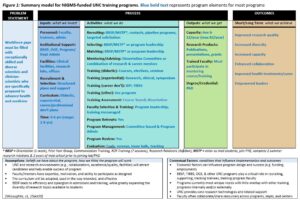Logic Models
Logic models are a visual representation of how you think your program inputs and activities will lead to your program outcomes (also called “program theory”). The format for logic models can vary; however, they generally include:
- Inputs: any resources or items put into the program
- Activities: any activities related to planning, implementing, or evaluating the program
- Outputs: any products resulting from the activities
- Outcomes: the effects of any outputs from the program; these are often divided into short-term and long-term outcomes
- Assumptions: beliefs about the program and how it will work
- External (or Contextual) Factors: conditions that influence implementation and outcomes, generally outside the control of the program director
Said another way, if we have [inputs], we can do [activities], which will result in [outputs] that impact [outcomes].
The logic model is a living document that should be reviewed regularly for accuracy and revision. It can also be utilized to determine evaluation questions and associated indicators for measuring program needs, processes, and outcomes. While outcomes evaluations are most common, evaluations at other stages of a program can also be critical for ensuring the program is appropriately designed. For example:
- At the point of inputs, a program director might ask “What resources are needed to implement the program?” or “Are the resources adequate to implement the program?”
- At the point of activities, a program director might ask “To what extent are the program activities implemented as planned?”
Figure 1 below represents a summary logic model that aggregates these elements for all of the T32 training programs included in the UNC NIGMS-funded project.
Template: T32 Logic Model Template
Example: T32 Postdoctoral logic model
Example: T32 Predoctoral logic model
For more information: Logic Model Guide
